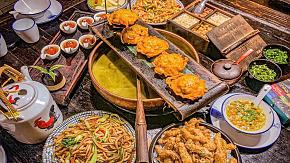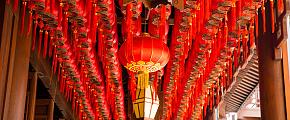Chinese Food - A Guide of 8 China Cuisines for Foodies
As a nation with so much passion for cooking, Chinese foods have various mouthwatering regional delicacies. From spicy Sichuan cuisine to mild Fujian cuisine, savor steaming hot pot, and dumplings with various fillings, China's culinary feast offers options for every taste. This guide highlights traditional dishes of the 8 Chinese cuisines that food lovers shouldn't miss, providing unique and unforgettable tastes throughout your China tour.
Chinese food is profound and diverse, benefiting from the complex geographical environment and the continuous integration of different cultures, and each regional dish in China has developed its own characteristic and distinctive flavor. Generally, it can be divided into 8 regional cuisines: Sichuan cuisine, Cantonese cuisine, Shandong cuisine, Fujian cuisine, Jiangsu cuisine, Zhejiang cuisine, Hunan cuisine, and Anhui cuisine.
Sichuan Cuisine
Sichuan cuisine is well-known worldwide. With a long history and unique flavor, it is regarded as the top of the 8 major regional cuisines. Sichuan people pay great attention to the selection and balance of ingredients in the dishes, and based on the five flavors: salty, sweet, numb, spicy, and sour, various seasonings are added to combine to form multiple compound flavors.
Kung Pao Chicken and Mapo Tofu, two typical foods found in almost every Chinese restaurant worldwide, represent Sichuan dishes the most. To use a proper metaphor, Sichuan cuisine is like a bomb of flavors that can significantly trigger and impact people's appetites.
Kung Pao Chicken
Kung Pao Chicken is a classic Chinese food made with diced chicken, peanuts, and chili peppers. A common cooking method is to stir-fry chicken with ginger and garlic, add various seasonings, and then mix in peanuts and dried chilies. This dish is delicious, slightly sweet, and spicy, and the peanuts add a nice crunch. Serve hot with rice or with vegetables like bell peppers or broccoli. Its flavor is similar to Western spicy chicken dishes, such as Mexican or Thai chicken.
Mapo Tofu
Mapo Tofu features tender cubes of tofu mixed with a spicy, savory sauce and minced pork, seasoned with chili bean paste and Sichuan peppercorns for a spicy kick. It's typically served over steamed rice, making it a hearty and satisfying meal. The bold and complex flavors of the food are reminiscent of spicy chili or curry dishes found in Western meal. Its intensity can be adjusted to taste, but it's generally enjoyed spicy, providing an exciting culinary adventure for those who love bold flavors.
.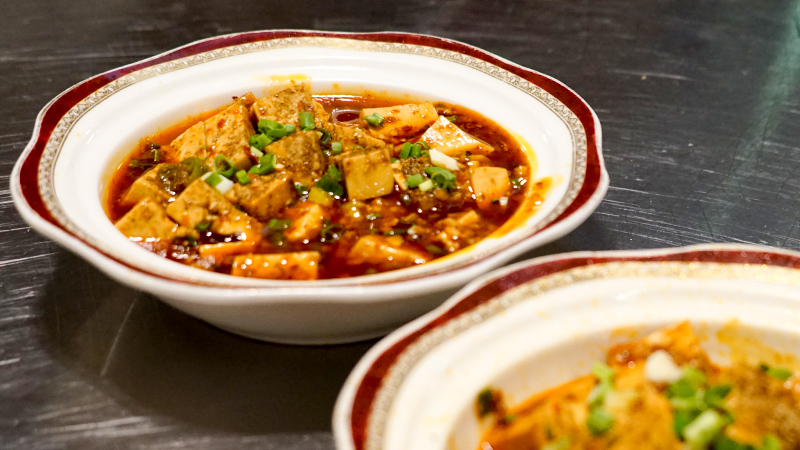 Mapo Tofu
Mapo Tofu
Cantonese Cuisine
Cantonese cuisine values the original flavor of the food, so the overall taste of Cantonese dished are relatively light to preserve the natural taste of the food itself. The best way to trigger the original taste of the food is by steaming and boiling. Therefore, Cantonese restaurants always serve you a bowl of soup first, and most Cantonese dim sum is mainly steamed. Famous Cantonese dishes include roast suckling pig, boiled white prawns, char siu, stewed pork with taro, etc.
Char Siu (Chinese BBQ Pork)
Barbecued pork is a Cantonese-style roast pork dish. To cook, marinate pork in a mixture of hoisin sauce, soy sauce, honey, and Chinese five-spice powder, then roast until caramelized. The char siu tasted sweet and savory with a slightly smoky flavor. If prepared correctly, char siu is some of the most tender, juicy, and tenderest pork you will ever eat. It's somewhat like Western roast pork or ribs and is best eaten with rice, noodles, or steamed buns.
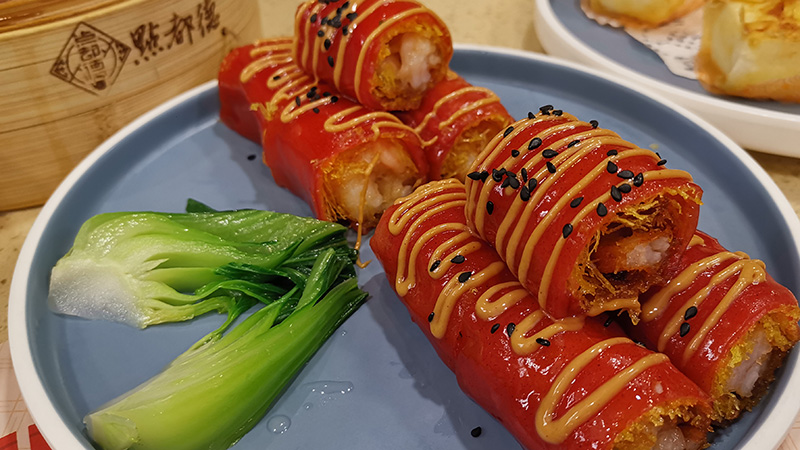 Cantonese Cuisine
Cantonese Cuisine
Shandong Cuisine
Shandong is located in the lower reaches of the Yellow River and has a mild climate, creating an exceptionally rich selection of ingredients for Shandong cuisine.
It emphasizes quick frying to maintain the quality and nutrition of the food while making the dishes refreshing and not greasy. In addition, Shandong Cuisine is famous for using shallots for flavoring. Its signature dishes are popular at grand Chinese banquets, such as roast duck, roast suckling pig, deep-fried pork hock, and deep-fried lamb with sesame sauce.
Roast Duck
Roast duck is a delicacy worth looking forward to when traveling to China, among which Peking roast duck is more characteristic. It has crispy skin, tender meat and bright red color, which is very popular. When served, the roast duck is usually sliced thin and paired with thin pancakes, scallion segments, cucumber and sweet bean sauce, all wrapped together for a multi-layered taste. The flavor of Peking duck is savory with a slight sweetness from the glaze, which suits most people's tastes. This makes it comparable to Western dishes like roast turkey or roast chicken, and they are also centerpieces for special occasions.
Fujian Cuisine
Fujian Cuisine features light taste and tenderness, similar to Cantonese dishes, but its ingredients are mainly seafood products. In terms of condiments, Fujian people are good at using peanut sauce and cha-cha sauce, which provide more sweetness. Moreover, the most prominent cooking is simmering, and from seafood to mountain treasures, all the fresh products can be incorporated into a pot of soup. The absolute status of soup has become the most significant difference between Fujian cuisine and other regional meals. Food such as ham in Rong soup, chopped meat with fish lips, and chicken noodle soup feature thick local characteristics of Fujian dishes.
Chicken Noodle Soup
If you like a light and delicious taste, chicken noodle soup will suit your taste buds. Put the whole chicken into the pot, add some seasonings, and simmer for several hours until the chicken is tender and the soup is rich. Then tear the chicken into small pieces, put it into the cooked soup, and add the noodles and vegetables. The chicken noodle soup has a sweet and refreshing taste, and the aroma of the chicken soup combines perfectly with the soft noodles, making it a comforting dish. It's perfect for a cold winter day or as a comforting meal after a day of traveling, and every bite is warm and satisfying.
Zhejiang Cuisine
Zhejiang has an advantageous geographical location and rich natural resources. To make it elegant and superior, Zhejiang people mainly use local seasonal specialties to highlight the regional characteristics of the food. They also focus on the use of fruits, vegetables, freshly killed seafood, and river products to diversify the dishes' contents while ensuring the food's pure taste. Representative Zhejiang cuisines are West Lake fish in vinegar gravy, Longjing prawn, Fenghua small clam, Nanhu crab meat, etc.
Longjing Tea Shrimp
Longjing tea shrimp is a unique flavor created by combining the famous Chinese tea with fresh shrimp. The dish is prepared by quickly stir-frying the shrimp in hot oil until just cooked, adding tea broth and leaves, and seasoning with a pinch of salt. It has both the deliciousness of seafood and the fragrance of tea. Similar to Western dishes like lemon shrimp or herb-infused shrimp, Longjing tea shrimp highlights the unique fusion of seafood and tea, which is a delicacy that is both cultural and yummy.
Jiangsu Cuisine
Fresh and elegant are name cards of Jiangsu cuisine. It is characterized by extreme attention to knife work. Whether it is the process of cold dishes, fancy hot food, or melon and fruit carving, all show exquisite knife skills. It emphasizes the original flavor, highlighting light and elegant colors and novel shapes. Jiangsu cuisine is famous for cooking duck and river food and is good at making exquisite desserts. Nanjing Salted Duck, braised fish head, steamed shad, widgeon dish, and chicken shreds with bean sprouts are all classic Jiangsu food you shall not miss.
Yangzhou Fried Rice
Fried rice is a staple dish in Chinese cooking and involves stir-frying cooked rice with a combination of ingredients such as eggs, vegetables (like carrots, peas, and bell peppers), and proteins. One of the famous variations is Yangzhou Fried Rice, known for its balanced flavors and inclusion of shrimp, pork, and eggs. Fried rice can pair well with a variety of Chinese food, including sweet and sour dishes, or as a side to complement main courses. Its chewy texture is like a Western stir-fry or Italian risotto, making it a comforting and flavorful meal option.
Hunan Cuisine
Hunan cuisine is heavy on oil and salt. Its color is vibrant because of the extensive use of chili peppers. Spicy is the central theme and soul of it. Eating pepper can stimulate saliva secretion and appetite and dispel rheumatism. Unlike Sichuan dishes, which are mainly hemp and spicy, Hunan cuisine tastes spicy and sour. Signature dishes of Hunan food include stir-fried pork with chili, fish head with minced pepper, and Changsha stinky tofu, etc.
Stinky Tofu
Stinky tofu, as its name suggests, has a strong smell like durian, but it tastes amazing. Tofu is fermented in salt water with vegetables, meats, and sometimes seafood, giving it its characteristic pungent smell. The fermented tofu is deep-fried until golden and crispy on the outside, and soft and tender on the inside. You may not be used to it at first, but once you accept it, you will find its infinite deliciousness. It's served with pickled cabbage and chili sauce and try it at many street markets, great for those who want to explore new flavors.
Anhui Cuisine
Anhui cuisine pays attention to the dietary regimen and mainly uses natural ingredients. It's worth noting that it has the effect of nourishing and maintaining health through food supplements and nutritional combinations. The strict mastery of fire in roasting, stewing, smoking, and steaming is also a fine tradition of Anhui dishes. It's an essential means for Hui cuisine to form a unique crispy, tender, fragrant, and fresh style. Stinky mandarin fish, Huangshan stewed pigeon, steamed partridge, and fired hairy tofu are notable Anhui dishes.
Stinky Mandarin Fish
Stinky mandarin fish, or "Chou Gui Yu," is a representative feature of Anhui cuisine. Fresh mandarin fish is soaked in a special brine that gives it a strong aroma, and then the fish is deep-fried until the skin is crispy and the meat is tender. Despite its strong smell, the dish has a strong salty flavor that creates a surprising collision of flavors when served with rice. Stinky mandarin fish is mainly found in Anhui restaurants, which offers adventurous food lovers a bold culinary experience compared to Western surstromming.
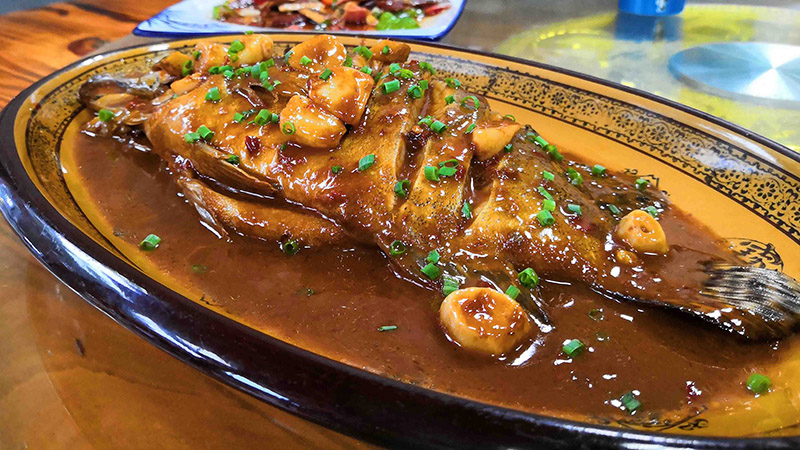 Stinky Mandarin Fish
Stinky Mandarin Fish
Two Popular Chinese Foods
Traditional Chinese food is a rich and diverse culinary heritage, offering a delightful array of flavors and textures. From the spicy dishes of Sichuan to the savory of Guangdong, each region brings its unique touch. Here are two classic dishes that may make you fall in love with Chinese food.
Hot Pot
Hot pot is a communal Chinese dining experience where different types of foodstuffs and ingredients are placed in a simmering pot of flavorful broth. Due to its Sichuan characteristics, hotpot is often mistaken for Sichuan cuisine. Common ingredients include thinly sliced meats, vegetables, tofu, and seafood. The flavors of hotpot range from light and delicious to spicy and fresh. The soul of hotpot lies in the various dipping sauces that can add rich flavor to the ingredients. It's usually served with a variety of side dishes, such as cucumber salad and vegetables, to balance the strong taste of the main dish. When eating, everyone sits around the pot and enjoys the fun of hot pot, which is both delicious and interactive.
Dumplings
As a traditional Chinese delicacy, dumplings are filled with meat, vegetables, or seafood, wrapped in dough, and can be boiled, steamed, or fried. They are usually served with soy sauce, vinegar, and chili oil, which are delicious and smooth in the mouth. Similar to ravioli or pierogi in the West, dumplings can be paired with a delicious soup base to form a complete staple. Using chopsticks when eating dumplings is somewhat challenging, but it is also a unique Chinese cultural experience.
Discover Your Chinese Food Journey With Odynovo
Discover Chinese food by experiencing its vibrant culinary scene firsthand in your China tour. From the spicy and refreshing flavors of Sichuan cuisine to the fresh and sweet flavors of Zhejiang cuisine, each region offers a unique taste adventure. Wander through bustling street markets, indulge in delights, and savor traditional dishes that have been perfected over centuries. Don't just dream about Chinese food - make it a reality with a tailored trip from Odynovo.
Quick Question
What Our Clients Say
Explore the latest verified reviews of Odynovo's travel services on Tripadvisor, Google, Trustpilot, Product Review and more trusted platforms.
SUBSCRIBE TO WIN A FREE TOUR
Subscribe to our newsletter for a chance to win a free 7-day tour to India! And more insider travel news, exclusive offers, and inspiration will be sent straight to your inbox. Check our previous newsletters and get some sparks.

